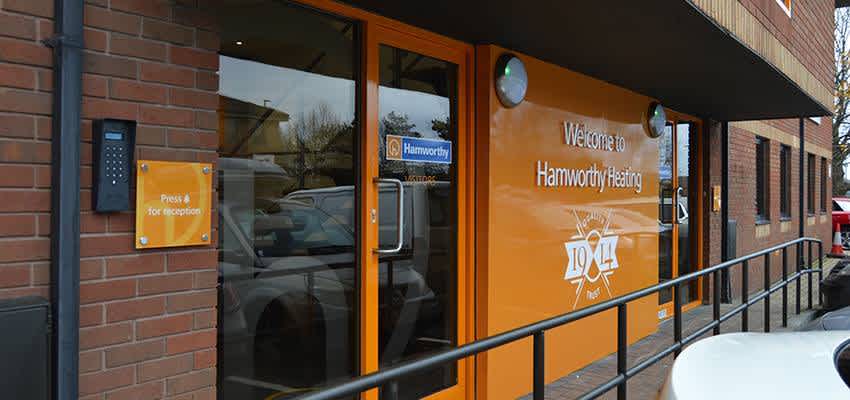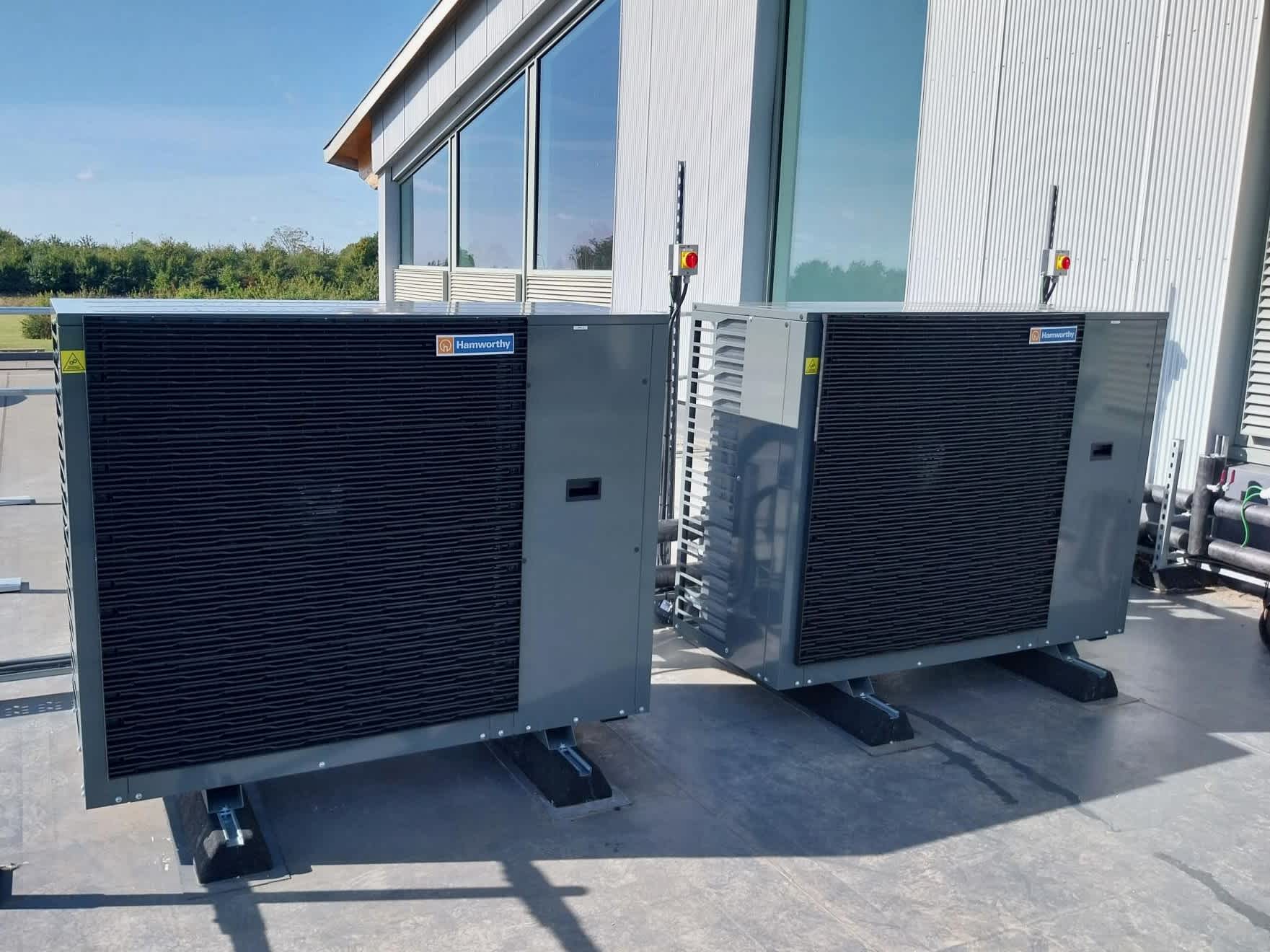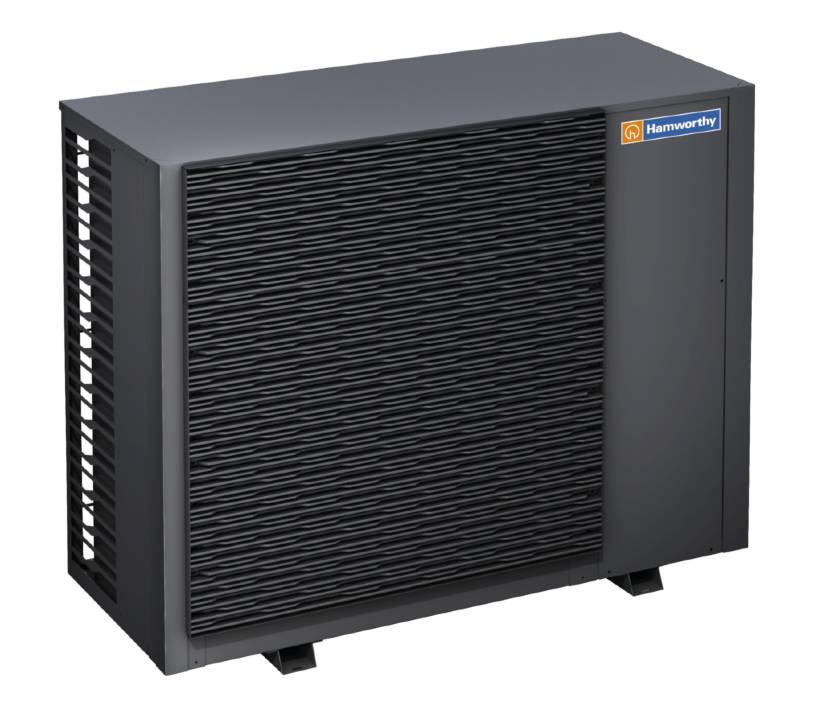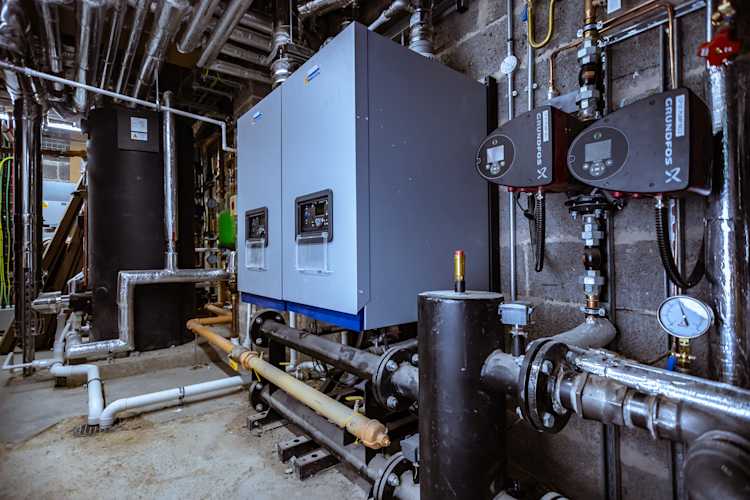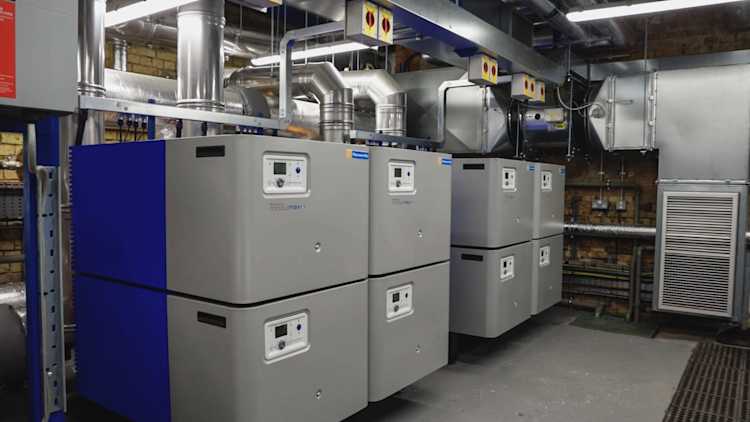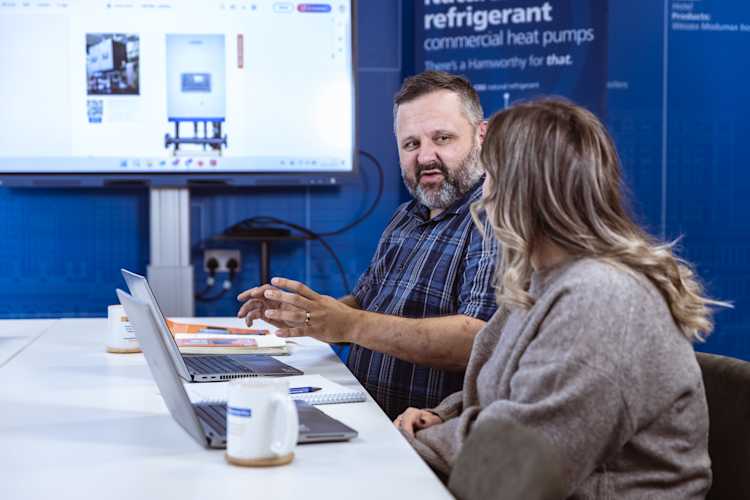History of Hamworthy Engineering
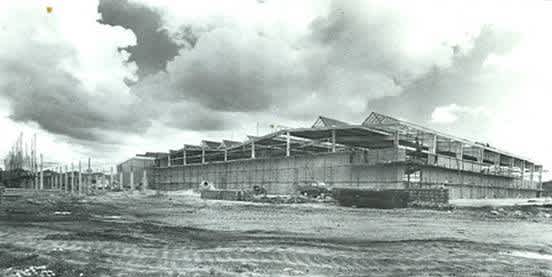
Why ‘Hamworthy’?
We took our name from the Parish of Hamworthy in Poole where the original works was located in 1911. This was convenient, as it was close to the London and South Western Railway’s goods station on the quay, meaning we could ship our products easily.
Why we’re still here
When we say “Everyone’s got history, we’ve got heritage”, we’re not using this lightly. Our backstory is diverse – from marine engine repair business to producing armament items during the first world war, engines, compressors, pumps and even – as unbelievable as it sounds – jam! Our foundry supplied Poole with municipal products such as manhole covers which you might still see today. While developments in the past meant it wasn’t always plane sailing – like two world wars and a big fire in 1936 – we’ve always been determined to make it work for the long-term.
The foundations
Our roots go all the way back to 1914 when our founder Percy Francis Hall renamed and incorporated his engineering company at Poole Quay “Hall’s Engineering” to “Hamworthy Engineering”. He had established the original business in 1911 which turned out to be highly successful and invited his brother Sidney Hall – at the time chief engineer at the Petter Engine Company in Yeovil, Somerset - to join him. One of Sidney’s achievements at Petter’s was a special engine speed governor which was found to be extremely efficient.Percy, who was looking after the production, had received a conventional education and decided to pursue a career in engineering which led him to as far as Mexico, working for the Tampico Navigation Company as oil exploration engineer. The start of the Mexican Revolution made him return to the UK – Poole to be exact – in 1911 where he established the marine engine and boat repair business.His brother Sidney was a member of the Institute of Mechanical Engineers, an authority on oil engines, and was reputed to have designed those made by Allens of Bedford and Marshalls of Gainsborough, Lincolnshire.
The First World War
Hamworthy Engineering is growing quickly and produces many essential armament items during the First World War – including turret rings for battleships. The Admiralty gives the company a ‘Class A’ Approval Certificate which means the products can be accepted without further quality control checks – a sign of extraordinary quality. A new machine shop is built by the Admiralty which ensures a very full order book. Demand is so high, women workers are employed on day and night shifts. The war drives the company ahead of the competition and allows it to become well established. In 1918, Percy Hall sets up a foundry about a mile from the works in West Shore Road, providing the company with their own secure supply of high quality castings. The foundry is to remain an important part of Hamworthy. Concentrating on the peace-time markets after the war has ended, Hamworthy continues manufacturing petrol-paraffin and oil engines, for both marine and land use, as well compressors and pumps.
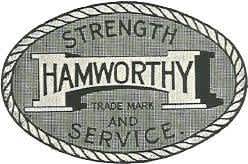
The ‘Roaring’ Twenties – Diversification, then Depression
Hamworthy’s robust oil engines gain sales quickly. They stand out due to being finished to an unusually high standard compared to rival machines, and also their colour: ‘fir green’ and coach-lines with gold leaf. Stationary or portable engines are initially made to meet local demand from fishing and other commercial craft, for powering deck cranes and winches but found extensive markets in many other applications from generating power to driving agricultural machinery. Many are sold abroad to the Empire countries and can still be found there today.
At the time, candles or oil lamps are commonly used to illuminate homes. Wealthier house owners can opt for a Hamworthy ‘Powerlight’, consisting of a semi-diesel engine driven dynamo and a cluster of heavy lead-acid accumulators for storing the power. Of course, a full after-sales service is also provided.
In the late 1920s, the economy takes a downturn and Hamworthy has to develop other products and get into other markets in order to survive. A most unlikely sideline includes pickles and jams produced by the works canteen’s French chef. ‘Frome Valley Preserves’ is kept quite separate from the engineering side and jars of jam are given to the workforce to supplement their wages when times are hard, and the firm has little money coming in.

The Thirties – storm clouds gather again
Despite the slump, Hamworthy keeps going with general or special engineering work, such as repairs and maintenance to anything from brick-making to agricultural machinery. The foundry produces a variety of municipal products such as manhole covers and lamp posts, many of which are still in use in Poole.
World trade recovers, Hamworthy Engineering does, too. Compressors and pumps in a variety of sizes for use in road mending, car washing, and paint spraying are made in increasing numbers. ‘Rotopax’ and ‘Transflo’ pumps are being supplied to the chemical and allied industries for moving a wide range of fluids from soap, at Lever Brothers and Pears factories, to highly corrosive acids. The Royal National Cordite Factory at Holton Heath buys several of Hamworthy’s Transflo pumps for use in processing highly corrosive nitric acid into nitro-glycerine. These had proved far more resistant to corrosion than other makes of pumps.
The Hamworthy fire
On 29th June 1936, the works catch fire. Despite quick action by the fire brigade, the upper floor of the building falls in with a terrific crash and flames shoot over fifty feet into the night sky. An even bigger crisis is just about averted: Fifty yards behind the works are Russian Oil Products Ltd storage tanks which hold half a million gallons of petrol. Had these blown up, half of Poole would have gone with it.
As a result of the fire, £20,000 worth of damage and 20-year old oil engine patterns are lost. Rebuilding the workshops starts immediately and finishes six months later at a cost of £731.
While this might have been the final chapter for some companies, Percy Hall immediately negotiates a deal with the firm’s main engine competitors whereby they agreed to purchase compressors and pumps for which, in return, Hamworthy will discontinue its own engine business. So, from 1936, engine manufacturing comes to an end, although spares are supplied for them until the mid-1940s.
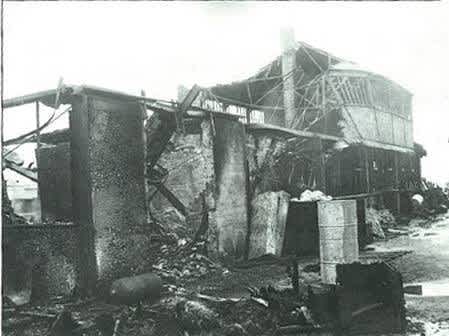
Hamworthy marine engines
For the first 25 years of the firm’s history, marine engines from 2.5 to 100 HP running on crude or refined oil are produced. Very reliable and powerful, they sell in great numbers and many are exported to Greece, South Africa, South America and Egypt – where the famous (but now in administration) travel agents Thomas Cook & Co. purchase several six-cylinder models to power their cruisers on the River Nile.
In 1928, the foundry moves to a site next to the works. As the decade comes to a close, Ingram Spencer, whose father owned a leading Glasgow stevedoring (loading with cargo and unloading a ship) firm, joins the company and sets about introducing new capital and business methods. Although few people at the time recognise the potential that is being injected in the company, the fortunes of Hamworthy Engineering are to change dramatically as a result.
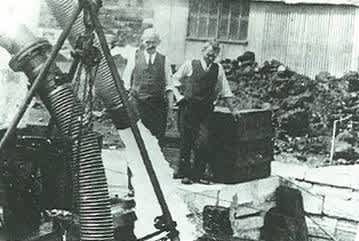
The Second World War Years 1939 – 1945
With the beginning of the Second World War, production increases in the 1930s. Hamworthy shifts to regular overtime to keep up with the demands from the War Ministry for pumps and compressors. Unlike many engineering companies in Britain, Hamworthy does not change to the manufacture of armaments after the outbreak of hostilities but is requested to continue with its regular work.
200 specially designed high-pressure compressors are made to assist rapid movement and recoil from anti-aircraft guns that are defending our towns and cities. The Navy’s new fast torpedo boats and assault ships are fitted with compressors to start their engines and two-stage high speed centrifugal pumps. Hundreds of trailer-mounted fire pumps are supplied to the Russell Newbery Fire Engine Co and are towed behind all types of motor vehicles, including buses and taxis, for emergency fire-fighting duties.
The Royal Navy becomes desperate when trying to sink German battleships. It requests a midget submarine as the only way the sink the ‘Tirpitz’ – a German battleship which was a danger to British convoys heading for Russia and operating from heavily protected Norwegian fjord. After two rival competitor compressor manufacturers fail to deliver, the Admiralty turns to Hamworthy for help in the desperate race to complete two very lightweight but powerful breathing air compressors. Hamworthy exceeds the requirements of a maximum weight of 50 pounds and to be able to operate at 3,000 p.s.i. Within six weeks, the contract is completed to an advanced design by Sidney Hall. Aluminium is used for the 19” high casing, a crankshaft in steel and phosphor-bronze for the high pressure piston which measures just 5/16th of an inch in diameter. The design is so advanced that the finished machines are capable of 5,000 p.s.i. and weigh only 46 lbs. A Naval security officer is attached to the works to oversee the construction and ensure complete secrecy. As soon as it is ready, the Admiralty sends a car to collect it without delay. The Tirpitz is successfully crippled by submarine and air attack which removes the threat to the allied shipping and staff, giving the Hamworthy team a reason to celebrate.
When the war is reaching its end, Ingram Spencer loses no time in turning his thoughts to ‘What next?’. Diversification is going to be essential for the growth of the company, but into which fields? The mines are running down, coal will be very expensive after the war. Oil, however, would be available in abundance, so why not turn to oil-burning equipment?
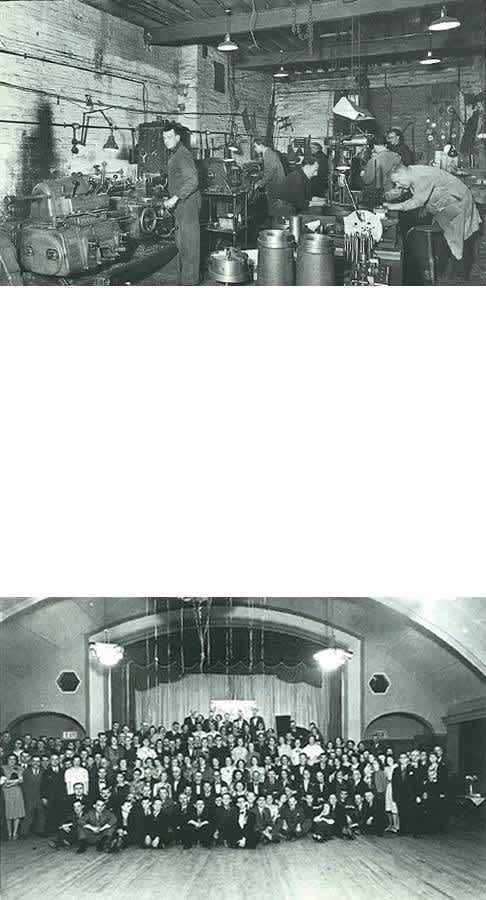
Post-war optimism
In 1945, Jack Tomlinson and Walter Kemp – both experts in the field of oil burning equipment - join Ingram Spencer. They form British Combustion Equipment Ltd to produce oil burners for ships, power stations and factories. Coupled with Hamworthy’s pumping knowledge, Hamworthy is now able to offer an attractive package of equipment for the coal to oil conversion.
Manufacturing these burners places a great strain on the limited resources of both the foundry and machine shop. Ingram Spencer is aware of Sidney Hall’s failing health and recruits the foremost compressor designer in the country, James Hendry, followed by Richard Peach, the then senior designer at Weir Pumps of Glasgow. The range of compressors for starting marine diesel engines designed by the team is far more advanced than anything else being produced by either Hamworthy or its competitors and their success is undreamed of. The order book is overflowing – thanks to increasing demand worldwide to replace ships lost in the war.
Hamworthy quickly establishes secure footholds in many countries where shipbuilding is a major activity, such as Norway, Holland and Germany. Spencer’s shipping connections and Hendry’s technical expertise open many doors which ensure the company’s export success: Hamworthy is expanding

Expansion in the 50s
The old premises soon become too small for diversification and the demands of the world-wide market. Compared to the old 2.5 acre site at Poole Quay, the Labour Club Sports Field at Fleets Corner – less than three miles from the original site – is found to be suitable for further expansion.
In August 1954 Chairman of the Poole Labour Club Alderman Reeves lays the foundation stone, the works open in April 1955. The ca. 21,000 square feet four-bay factory is fronted by a spacious three storey office block. The premises at the Quay are now devoted entirely to the Pump and Compressor division. The oil-burner business takes off which most of the new site is devoted to.
Getting serious with the diversification business
In 1939, Hamworthy starts producing gear pumps and hydraulic valves designed by Sidney Hall for Ruston-Bucyrus, the bulldozer and excavator makers in Lincoln. While considerable quantities are made until 1953, Ruston decides to manufacture them at their own factory.
Hamworthy becomes a licensee of the Hydreco Division of the American company New York Air Brake, securing an extensive franchise and technical information for this type of equipment. Hamworthy Hydraulics Ltd is formed from this association, as a 50% owned subsidiary of Hamworthy Engineering.
All this wouldn’t have been possible without the extraordinary success of the pump and compressor sales. Hamworthy is now in the marine business in Holland and Scandinavia, Canada, Greece, Italy and France. A substantial number of diesel-engine ships being built in western shipyards are equipped with Hamworthy compressors or pumps, or in many instances both. In parallel with the marine market, business is being developed with refinery and chemical plants.
In January 1925, Sidney Hall dies after a long illness. Founder Percy Hall retires in 1957 and is given a fond farewell by everyone at the firm.
The exciting 60s – expanding the factory and becoming Poole’s biggest employer
By 1960, the Fleets Corner factory has grown by seven bays, now occupying a total production area of 37,000 square feet. Some 750 men and women are employed, and apart from the development of Combustion and Hydraulic work, the Foundry has been steadily expanding with mechanical plant and other improvements.
It soon becomes clear that the potential of the firm is tremendous and far beyond the capability of a private company to sustain. Ingram Spencer is looking for a suitable partner in the market.
In 1962, Powell Duffryn Limited, a conglomerate with interest in shipping, oil and chemical storage, retail fuel distribution and timber, acquires Hamworthy Engineering Ltd and its 50% share of Hamworthy Hydraulics Ltd for £3.2m. In 1964, Percy Hall dies at his home in Poole, aged 77, just two months before the company’s 50th anniversary. The old quayside site is finally closed down and sold the following year, when the Pump & Compressor division moves to new workshops and offices at Fleets Corner which increases the total works area to 27 acres. The turnover has risen to £10m a year and the company now employs over 2,000 staff.
In the 60s, Hamworthy Heating emerges as one of the specialist divisions.

The turbulent 70s
Pressure to compete internationally increases in the 1970s. Employees are faced with inflation which accelerates at an alarming rate. Worker strikes mean a three-day working week and supply problems, but Hamworthy is determined to succeed. The established subsidiaries in foreign countries prove to be especially valuable for market penetration. Especially the Pump and Compressor division in Australia and Canada as well as licensing arrangements for some products in Japan have secured a substantial stake in the shipbuilding machinery market worldwide.
Between 1966 and 1978 Hamworthy Hydraulics Ltd continues to expand its manufacturing facilities. Subsidiary companies were established in France, West Germany, Sweden, Finland, Norway, Denmark and Italy.
The Transmissions Division is set up in 1971 – another major investment. Initially aimed at the mobile plant axle and gearbox market, the potential is clearly established for substantial business in other applications such as winches and cranes, both land-based and marine. A new factory is built on the Fleets Corner site. By March 1979, it covers about 85,000 square feet complete with a three storey office block. Hamworthy Engineering’s investment in plant totals some £3.4m turnover for the year 1978/1979.

The Enterprising Eighties
The economic climate worsens in the 80s. Hamworthy Foundry changes its name in 1983 to Powell Duffryn Castings following a recent major programme of investment. It is not only supplying Hamworthy Hydraulics Ltd but also large car manufacturers such as Jaguar, Ford, Austin Rover, Renault and BMW.
In 1986, Hamworthy Engineering acquires compressor company Williams & James Ltd of Gloucester along with two more firms the following year. Bristol Pneumatic, a company well known for breathing-air products, is moved to the Gloucester site with most of the staff from the original Bristol factory. The Birmingham-based burner manufacturer Radiant Superjet is also purchased to enlarge the Combustion Division’s product range. In 1988, two more companies join the growing group: Hygate Gears Ltd, a privately owned, high quality gearbox engineering specialist in Bath, employing over 100 people. Then later, the Newport (Gwent) foundry S.V. Castings.
During 1988, the rapid expansion of Hamworthy Engineering results in the company taking a fresh look at its diverse operations which, although using related engineering skills, are each meeting different needs for different industries. From the original divisions come ‘new’ subsidiaries, each one registered as a Limited company in its own right.
The Hamworthy group then consists of Hamworthy Pump and Compressor Ltd (now Wärtsilä), Hamworthy Hydraulics Ltd (now Hydreco), Hamworthy Combustion Systems Ltd., Hamworthy Heating Ltd (us!), Hamworthy Compressor Systems Ltd (formed from the amalgamation of Williams & James and Bristol Pneumatic in 1987), Hamworthy Hygate, Hamworthy Castings and Powell Duffryn Castings.

Today
In 2008, Hamworthy Heating became part of international heating and hot water manufacturer Groupe Atlantic.
We occupied the site at Fleet’s Corner – including its manufacturing facilities – until 2017, when we moved production to the Group Atlantic factories in Hull. In the same year, we have also moved to a new office – just around the corner – including a new showroom with all our products.
To this day, we're continuing the spirit of innovation with our modular boilers. We not only pride ourselves in reliable high quality products but also in a friendly team that's dedicated to delivering great customer service.
